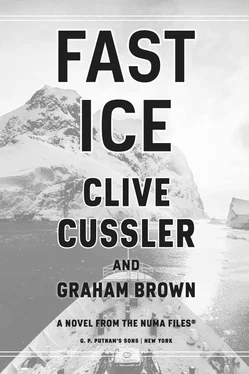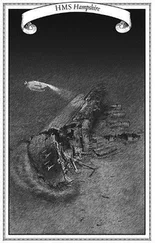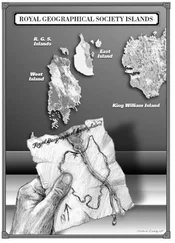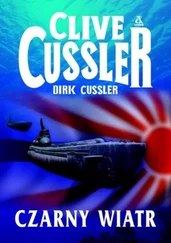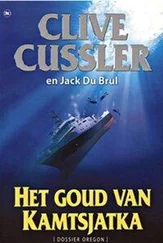Low levels of red light streamed through the keys, illuminating each letter, while screens set to minimum brightness showed the condition of the high-pressure turbine her team had recently installed.
Everything in front of Yvonne suggested the turbine was operating flawlessly, but she preferred a hands-on report to the opinion of a computer. She picked a radio off the charger and spoke into it.
“All markers showing nominal,” she said. “What do your eyes and ears tell you?”
Yvonne’s foreman was three hundred yards away and a hundred feet beneath the surface. A relay system connected his radio to the world aboveground. “No signs of vibration,” he said. “Pressure holding. We can begin drawing the lake water whenever you’re ready.”
She was more than ready. Eleven weeks of constructing an underground tunnel to the sea had felt like torture. Cora’s betrayal and the sudden interference of NUMA had become a major last-minute threat. All that was about to become irrelevant.
She tapped a key on the control computer. “Valves opening . . . Water flowing . . . Keep an eye on everything and let me know if you spot any problems. If everything continues looking good, make your way back to the compound.”
The foreman didn’t hesitate long before replying. “If it’s all the same with you, I’d rather stay put,” he replied. “Just in case something goes wrong, I’d rather be here where I might be able to do something about it.”
Yvonne understood. Her foreman wanted to remain at his post, like a master chief in the engine room of a great vessel. That didn’t surprise her. All of them knew that the crucial moment had arrived and each seemed to deal with it in a different way.
For some, it would mean celebration. For others, a deeply spiritual moment of communion with the environment that they were trying to save.
Yvonne didn’t know what to feel. At least the work would be done. The future course altered. Years of struggle at last paying its dividend. Instead of euphoria, she found exhaustion creeping in.
She glanced around the room. In addition to herself and the foreman, nine others remained at Base Zero, eight of them members of the tactical team, the same team that had stormed the Grishka almost three months before.
Ryland had insisted they transfer to the base to protect the turbine that would pump the lake water through the ice tunnel.
After helping deliver and install the high-pressure turbine, these men had had little to do. To Yvonne’s surprise, this level of inactivity had affected the group, particularly a man they called High Point. He was the team leader and the man who’d shot Cora and the others on the deck of the Grishka .
Perhaps his unease made sense. As a sniper, he was used to being camouflaged in a hiding place where he could watch over large swaths of territory. Being cooped up inside a target as obvious as a building made him feel vulnerable.
At the moment, he sat nearby, tapping away at another laptop, cycling through the views from a bank of cameras he’d deployed. Some of them visual wavelength, most operating on infrared.
With little to see but darkness, he got up and walked over to the windows. They were covered on the inside with condensation. He wiped the window down only to find the outside caked with snow and ice.
“We’re too passive here,” he said, turning to Yvonne. “We’re easy targets, should anyone attack.”
Yvonne was not concerned. “The only people who even know about us are those fools from NUMA. My brother has an eye on them. Their nearest ship is a thousand miles away, struggling in the storm and heading directly back to where the Grishka sank. They’re lost and grasping at straws.”
“We should have set up a portable radar,” he said.
Yvonne shook her head. “A radar beam would lead them right to us. They could follow it down like a homing beacon.”
“Lookouts, then.”
She motioned toward the window and the blowing snow. “Be my guest.”
He glanced toward the window, said nothing.
“It’s twenty below out there,” she pointed out. “That storm is going to get worse before it gets better. Until then, we don’t have anything to worry about.”
He turned without a word and went back to his desk. Slumping into his own canvas chair, he began cycling through the cameras once again.
He’d placed a ring of them around the habitat and others farther out on the rocky ridge above the valley. The most distant unit was three miles off and its signal had been lost in the storm. While closer cameras were still downloading images, half their lenses were now covered over in snow.
And yet, one of them had picked up something that wasn’t cold and dark.
He leaned closer, froze the image and then called Yvonne over. “Look at this.”
She got up and walked to his side. Studying the screen, she saw a thermal image that was blurred and flickering. It looked like a blob of orange and blue on a field of black but became more distinct as High Point tapped at the keyboard.
“It’s moving,” he said.
“Track it,” she ordered, suddenly concerned. “Zoom in.”
High Point locked the thermal camera and tightened the focus. It resolved into a discernible picture. Four human-shaped targets riding on a pair of machines.
“Snowmobiles?”
“Hard to tell,” he said. “They’re not making a lot of heat. Based on the speed, though, I’d say yes.”
Her heart began to pound. A sense of embarrassment at her earlier bravado hit, combined with the fury of dealing with more outside interference. “Where are they?”
“They’re on the high side of the valley,” he said. “Must be trying to stay out of the wind by hugging the ridgeline. But they’re headed right for us.”
The images began to fade as they pulled out of range.
“We’re losing them.”
“They should show up on the next camera any moment.”
He tapped a key and the image switched. It was dark at first, and then the glowing shapes emerged out of the darkness.
“Send three of your men out to the drilling rig,” she ordered. “You and the rest of them come with me. We’re going to spring a trap and deal with this annoyance once and for all.”
46
Kurt was at the controls of one snowmobile, with Joe seated behind him and two backpacks filled with explosive charges strapped to the sides. Paul and Gamay rode an identically loaded machine a few feet to their right and ten feet back.
The trip from the helicopter had been strenuous, as they fought the wind, the snowdrifts and the darkness. Of the three, the dark was the worst.
The snowmobiles had a night vision system built in. It linked to a heads-up display projected on the windshield in front of the driver. So far, it had proved itself to be almost useless.
Like most night vision systems, it worked by amplifying visible light. Yet amid a storm, in the middle of the Antarctic night, almost no light at all was reaching the ground. What it did pick up were millions of chaotically swirling snowflakes.
Switching to infrared mode proved slightly more effective. Kurt was able to see a difference between the landforms and the sky, the difference between rocks and snow. Ironically, the snow was warmer. But deep drifts and drop-offs were hard to spot. And despite riding at a reduced speed, they still had occasion to take urgent evasive action.
With little choice in the matter, they’d been forced to turn on the headlight that was tucked underneath each snowmobile’s chin. Like fog lights on a sports car, it was supposed to illuminate the ground but not the falling snow. They offered, at best, fifty feet of visibility. Even that was an improvement.
Because Kurt had to concentrate so intently on the actual driving, he was relying on Joe for directions. Joe had the GPS tablet locked in a stand. He was using the map that Rudi and Hiram had created from the reconnaissance flight to help them avoid areas of rough terrain or fissures in the ice waiting to swallow them up.
Читать дальше
